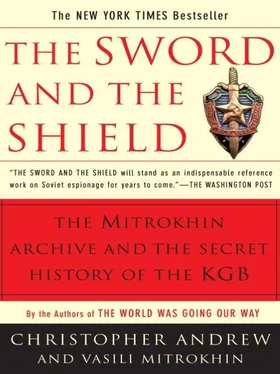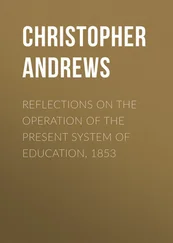I unconditionally recognize Soviet power and no other. To every Russian who loves his country I, who have traversed the entire road of this bloody, heavy struggle against you, I who refuted you as no one else did, I tell you that if you are a Russian, if you love your people, you will bow down to worker-peasant power and recognize it without any reservations. 55
The deception of Savinkov continued even after he was sentenced to fifteen years in jail. He failed to realize that his cellmate, V. I. Speransky, was an OGPU officer, later promoted for his success in gaining Savinkov’s confidence and surreptitiously debriefing him over a period of eight months. 56Savinkov did not long survive Speransky’s final report on him. KGB files appear to contain no contemporary record of how he met his death. According to the SVR’s implausible current version of events, Savinkov fell or jumped from an upper-story window after a congenial “drinking bout with a group of Chekists”—despite a heroic attempt to save him by Grigori Syroyezhkin. 57It seems more likely that Syroyezhkin pushed him to his death. 58
Even more successful than SINDIKAT was operation TREST, the cover name given to a fictitious monarchist underground, the Monarchist Association of Central Russia (MOR), first invented by Artuzov in 1921 and used as the basis of a six-year deception. 59By 1923 the OGPU officer Aleksandr Yakushev, posing as a secret MOR member able to travel abroad in his official capacity as a Soviet foreign trade representative, had won the confidence during visits to Paris of both Grand Duke Nikolai Nikolayevich, cousin of the late Tsar Nicholas II, and General Aleksandr Kutepov of the [White] Russian Combined Services Union (ROVS). The leading victim of the deception, however, was the former SIS agent Sidney Reilly, an even greater fantasist than Savinkov. Reilly had become a tragicomic figure whose hold on reality was increasingly uncertain. According to one of his secretaries, Eleanor Toye, “Reilly used to suffer from severe mental crises amounting to delusion. Once he thought he was Jesus Christ.” The OGPU, however, failed to grasp that Reilly was now of little significance, regarding him instead as a British masterspy and one of its most dangerous opponents. On September 26, 1925 it succeeded in luring him, like Savinkov a year before, across the Russian frontier to a meeting with bogus MOR conspirators. 60
Reilly’s resistance after his arrest did not last much longer than Savinkov’s. His KGB file contains a letter, probably authentic, to Dzerzhinsky dated October 30, 1925, in which he promised to reveal all he knew about British and American intelligence as well as Russian émigrés in the West. Six days later Reilly was taken for a walk in the woods near Moscow and, without warning, shot from behind. According to an OGPU report, he “let out a deep breath and fell without a cry.” Among those who accompanied him on his final walk in the woods was Grigori Syroyezhkin, the probable assassin of Savinkov a year earlier. Reilly’s corpse was put on private display in the Lubyanka sickbay to allow OGPU officers to celebrate their triumph. 61Appropriately for a career in which myth and reality had become inextricably confused, rumors circulated for many years in the West that Reilly had escaped execution and adopted a new identity. The TREST deception was finally exposed in 1927, to the embarrassment of the intelligence services of Britain, France, Poland, Finland and the Baltic states who had all, in varying degrees, been taken in by it. 62
AS WELL AS engaging in permanent conflict with counter-revolution, both real and imagined, Soviet intelligence between the wars also became increasingly successful in penetrating the main imperialist powers. It had two major operational advantages over Western intelligence agencies. First, while security in Moscow became obsessional, much Western security remained feeble. Secondly, the Communist parties and their “fellow travelers” in the West gave Soviet intelligence a major source of ideological recruits of which it took increasing advantage.
While operation TREST was at its height, INO, the OGPU’s foreign intelligence service, succeeded in making its first major penetration of the British foreign service. The penetration agent was an Italian messenger in the British embassy in Rome, Francesco Constantini (codenamed DUNCAN), who was recruited in 1924 by the OGPU residency with the help of an Italian Communist, Alfredo Allegretti, who had worked as a Russian embassy clerk before the Revolution. Despite his lowly status, Constantini had access to a remarkable range of diplomatic secrets. 63Until the Second World War, the Foreign Office did not possess a single security officer, let alone a security department. Security in many British embassies was remarkably lax. In Rome, according to Sir Andrew Noble, who was stationed at the embassy in the mid-1930s, it was “virtually non-existent.” Embassy servants had access to the keys to red boxes and filing cabinets containing classified documents, as well as—probably—the number of the combination lock on the embassy safe. Even when two copies of a diplomatic cipher were missing in 1925, it did not occur to British diplomats that they might have been removed by Constantini—as they almost certainly were. 64
For more than a decade Francesco Constantini handed over a great variety of diplomatic documents and cipher material. Probably from an early stage he also involved his brother, Secondo, who worked as an embassy servant, in the theft of documents. In addition to despatches on Anglo-Italian relations exchanged between London and the Rome embassy, Constantini was often able to supply the “confidential print” of selected documents from the Foreign Office and major British missions designed to give ambassadors an overview of current foreign policy. 65By January 1925 he was providing, on average, 150 pages of classified material a week. Constantini made no secret of his motives. The Rome residency reported to the Centre, “He collaborates with us exclusively for money, and does not conceal the fact. He has set himself the goal of becoming a rich man, and that is what he strives for.” In 1925 the Centre pronounced Constantini its most valuable agent. Convinced of a vast, nonexistent British plot to destroy the Soviet state, it counted on agent DUNCAN to provide early warning of a British attack, and instructed the Rome residency:
England is now the organizing force behind a probable attack on the USSR in the near future. A continuous hostile cordon [of states] is being formed against us in the West. In the East, in Persia, Afghanistan and China we observe a similar picture… Your task (and consider it a priority) is to provide documentary and agent materials which reveal the details of the English plan.
The Rome residency’s pride in running the OGPU’s leading agent is reflected in its flattering descriptions of him. Constantini was said to have the face of “an ancient Roman,” and to be known to his many female admirers as “the handsome one.” 66By 1928 the OGPU suspected him—accurately—of also supplying documents to Italian intelligence. Despite suspicions about Constantini’s honesty, however, there was no mistaking the importance of the material he supplied. Maksim Litvinov, who by the late 1920s was the dominating figure in the People’s Commissariat for Foreign Affairs, pronounced it “of great use to me.” 67
THE OGPU’S FIRST successful penetration of the British foreign service was overshadowed in 1927 by an embarrassing series of well-publicized intelligence failures. The security of the rapidly expanding foreign network of OGPU and Fourth Department (Military Intelligence) residencies was threatened by the vulnerability of early Soviet cipher systems to Western cryptanalysts, by the inexperience of some of the first generation of INO officers, and by errors in the selection and training of foreign Communists as agents. The International Liaison Department (OMS) of the Communist International provided a ready pool of enthusiastic volunteers for Soviet intelligence operations. Some, such as the German Richard Sorge, were to be numbered among the greatest spies of the century. Others ignored orthodox tradecraft and neglected standard security procedures.
Читать дальше











